And trying to correct an old bad habit.
Six days ago I was in the right place at the right time when a trio of swans began to take off from the ice at Bear River MBR. I managed to get about 20 shots of one of them during the takeoff process with very few clipped or cut off body parts. But some of them had other problems, including having the bird too close to the frame edge and photos that needed rotation because I didn’t keep my lens level.
As we’ll see, rotating images during processing to get them level can cause its own problems.
Below are some of my favorites, presented in the order they were taken. Readers using a mouse can tell how many “skips” there are between each shot (if any) by passing your cursor over the photo and reading the image file number. I posted one of the photos five days ago but all the rest are new to Feathered Photography.
Image techs for these photos are 1/2500 – 1/3200, f/8, ISO 800, Canon 7D Mark II, Canon EF 500mm f/4L IS II USM
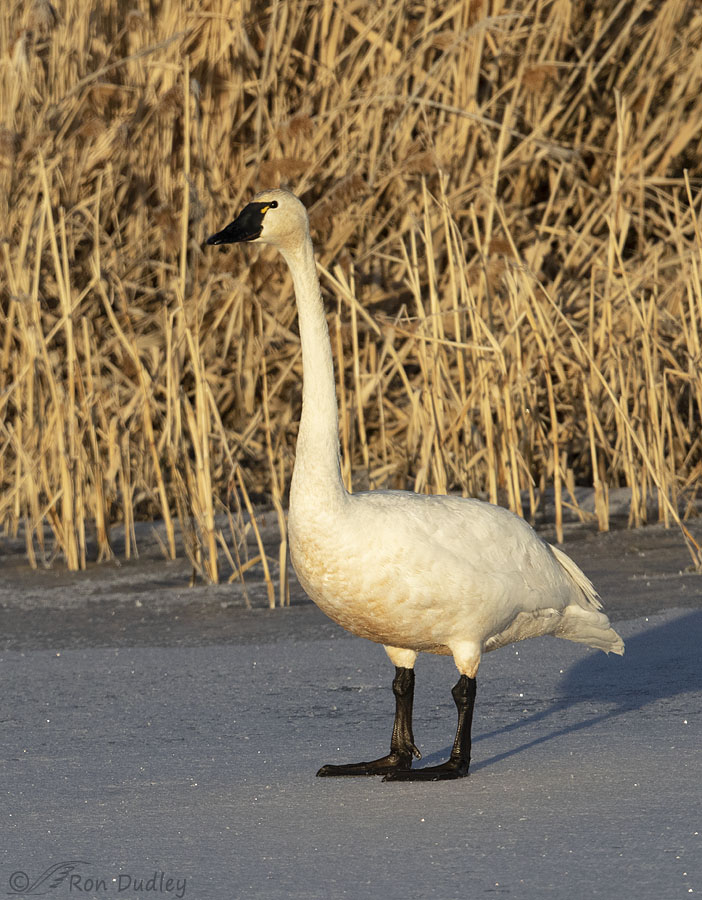
If memory serves there were three swans in the small group – two Tundra Swans and one Trumpeter Swan. I could tell from their behavior that they were likely to take off soon so I focused on this Tundra Swan because “he” was in front of the other two and my goal was takeoff and flight shots of a single bird without one bird blocking the view of another.
Besides, I was way too close to more than one bird sharp.
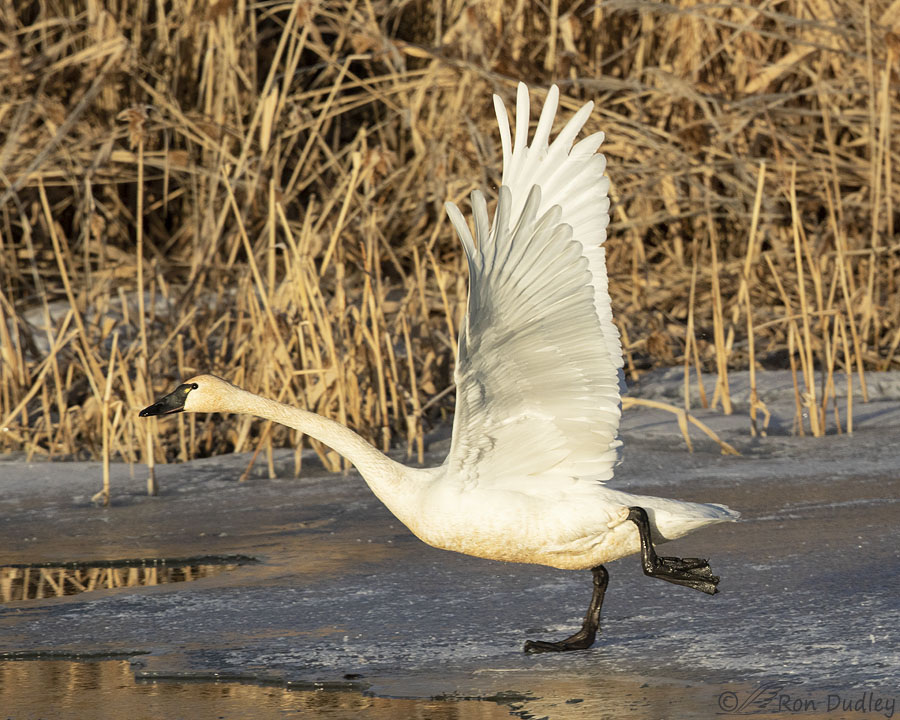
I was just a little surprised by how fast such a huge bird could accelerate on slippery ice so this first shot I’m including of the takeoff process was a couple of frames after he began to run. As you can see he’s about to transition from ice to water.
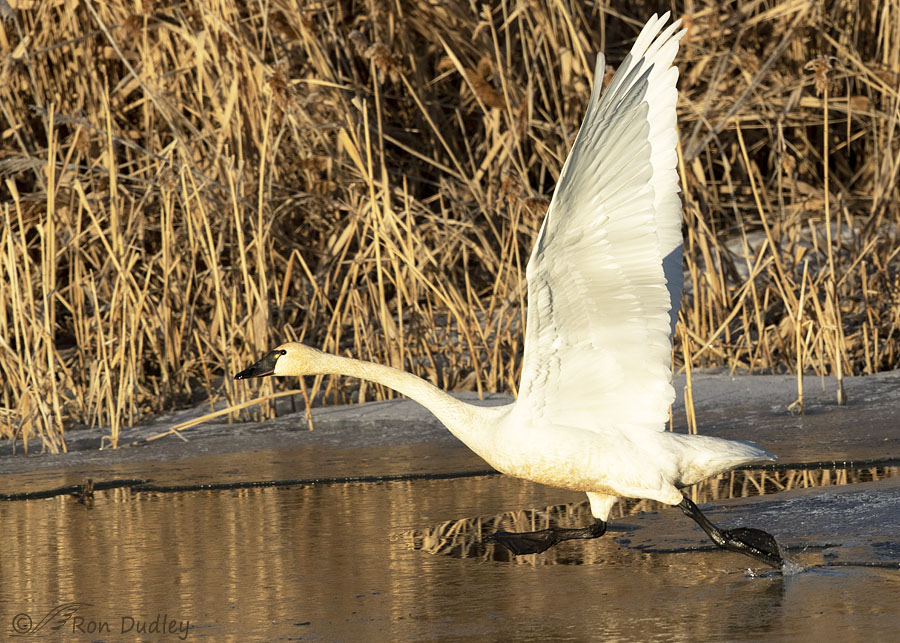
There was actually very little water without at least some ice on top. There was thicker, old ice but most of the water had a paper-thin film of new ice that had formed during the cold night. There’s a perimeter of ice-free water surrounding the peninsula of thicker ice behind the swan’s feet.
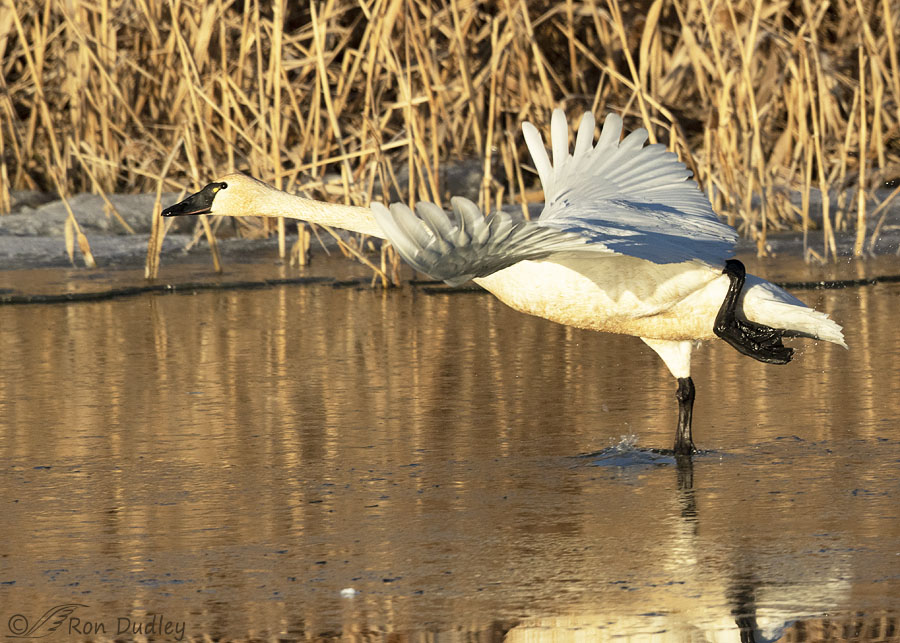
He took the transition from ice to water completely in stride. The small, white down feather on the water at the bottom of the frame is a good indicator of…
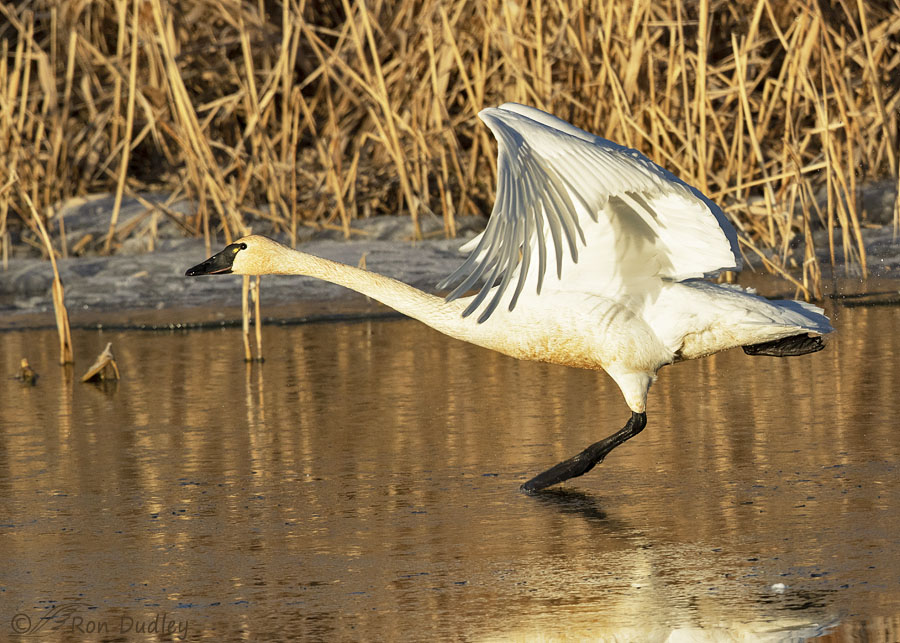
how far the swan traveled in the 1/10th of a second between shots.
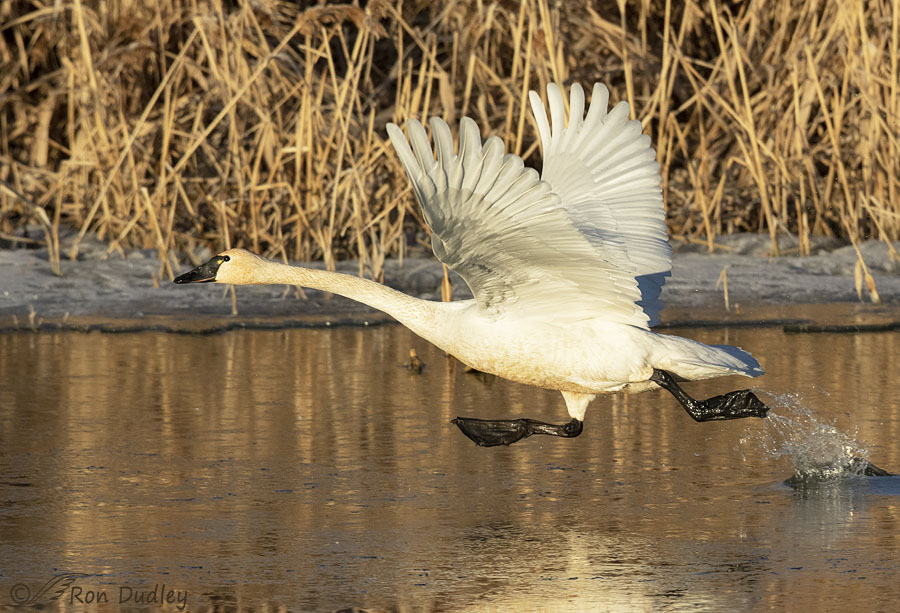
This is the photo I posted five days ago. I’m including it again to keep the series as complete as is practical and because it’s one of my favorites.
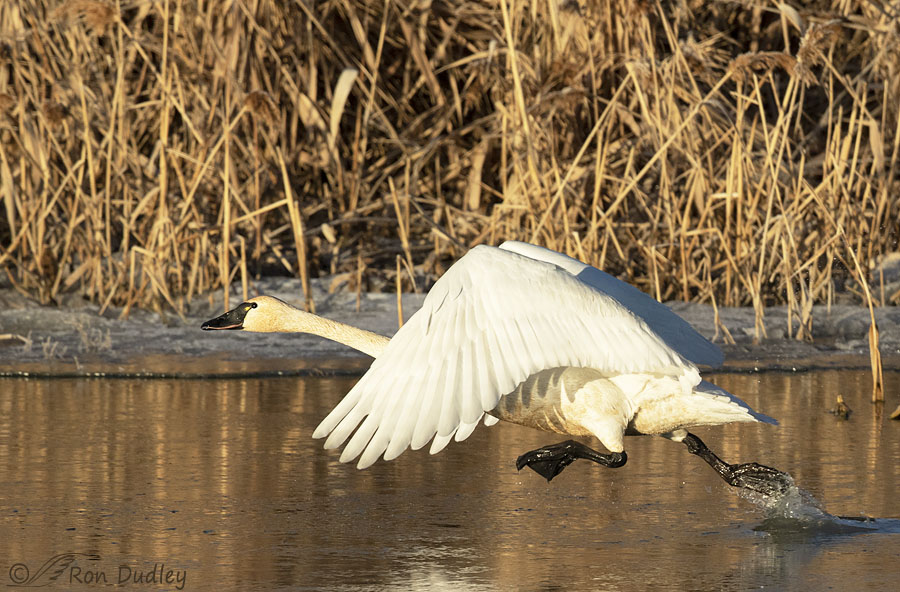
At this point he’s really building up a head of steam.
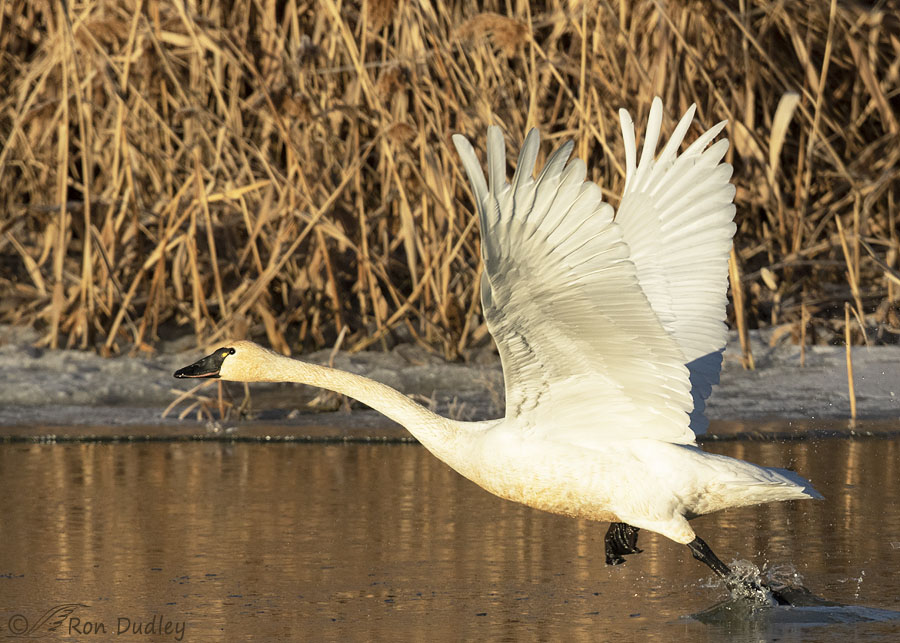
This is the last photo I’ll include, in part because the swan was beginning to get past me.
I was beginning to think I wouldn’t be able to get a swan takeoff series this year before they were gone for the breeding season so I was happy to get this one. There’s just something about swans in Utah in late winter that tickles this photographer’s fancy.
Ron
PS – At the last minute I decided to show readers one of the challenges I was dealing with while photographing this swan. It has to do with operator error and an old bad habit of mine.
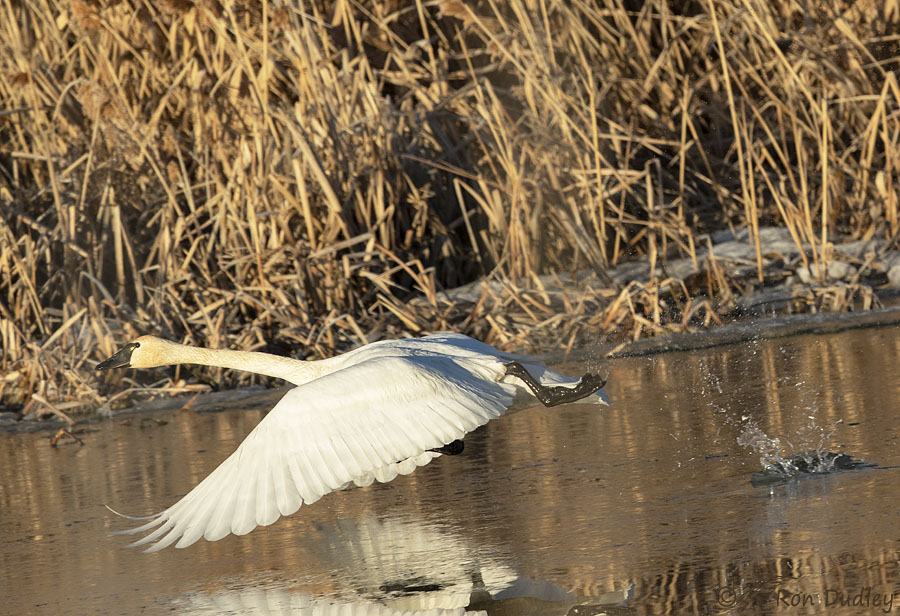
When I’m tracking a bird in flight to my left with my lens sticking out my pickup window I have an unfortunate tendency to rotate my lens clockwise. It has something to do with twisting my back and shoulders as I try to keep the bird in the frame.
The result is images like this one that need counterclockwise rotation to make them level. Photos that obviously need rotation drive my sensibilities more than a little bonkers. I can’t see past the obviously tipped image to appreciate any strengths the photo might have.
But if the bird is this close to the frame edge the process of leveling the image cuts off part of the bird. It drives me nuts when that happens to an otherwise good photo but it’s a bad habit I just haven’t been able to completely break.
But I’ve only been trying for 14 years so give me some time…


Catching up on posts. These are beautiful. I love the light.. Yes they are fast. I had to wrangle a few and even severely injured they gave a good chase. Their neck is very strong and to hold wings and head of a big heavy bird was challenging for me.
Wonderful series, Ron. Even the last “tilt” shot is great. I’m marveling at how little the change in the surface affects the swan’s stride.
Thanks, Marty. I enjoy seeing that tilted shot too, but it does make my eyes water…
Any chance of seeing a photo where the Trumpeter is with the Tundra? I’d like to see how to easily id one from another. I’m not a swan master…yet. 😀
Arwen, I didn’t get a single photo of the Trumpeter. I was so intent on having this guy in my viewfinder (because he was the bird in front) when he took off I didn’t want to risk missing his takeoff. Sorry.
Those boots and knobby knees—memories of my childhood! 😂 (Fortunately, not quite so severe…)
I’m intrigued by the huge lift of the left leg in the 4th photo, that’s quite a convolution of body mechanics … hurts my hips and spine just to think about it. And your previously posted photo with legs, feet and wings up — all systems “go” for launch! Another fun series, thanks.
Got a big kick out of your first sentence, Chris. One of my first smiles of the day and it’s late.
Happy to oblige! 😉
Hoofin’ it and winging’ it. The series makes me appreciate the coordination needed to get airborne.
I never realized Tundra Swans had seriously thick legs and knobby knees, and a raised hallux.
Lyle, I guess it takes seriously thick legs to support a seriously heavy body.
Must add my thank you! These are really beautiful. And thanks for sharing!!
Snow and lots of it today in Western Massachusetts. Many birds happy to find my feeders.
I totally love the footwork in these shots. A great, great series. The twisting/leveling problem is unlikely to be solved I should think without a complete realignment (i.e.evolution) of the human framework so, if we check back in the next couple million years, do you think there will be a new human subspecies perhaps called autophotobius? 😉 (apologies to all, the devil made me do that)
Ha, I don’t think it’s all that difficult physically to twist your upper body without rotating the lens, Granny Pat. Even I can do it. I just can’t REMEMBER to do it in the excitement of the moment.
Mary, I filled my feeders this morning after forgetting for a few days. Don’t have many birds out there though.
Beautiful images, 5190 is my favorite. I have noticed that whenever I mouse over your images they get lighter.
Yes, they do get lighter with the cursor over them, Jo – I think by dramatically decreasing the contrast. They don’t look good that way but it’s the only way for viewers to see the image file numbers.
Excellent series Ron. Nature is certainly remarkable. Wonder if the bottom of their feet are rough giving them some traction when taking off from ice? I am missing our visiting Tundra Swans. We had a series of almost two weeks of very warm days with temps in the low to mid 60’s every day. Possibly that drove them away. They normally stay for a minimum of two months.
Everett, they won’t be here for much longer either. I suspect some of them will be heading north quite soon.
Big black boots with gripper-nails ! What a feature for a critter so elegant
looking above the knee…….as beautiful as he is, I was suddenly reminded
of those old black rubber boots that humans wore in the 40’s and 50’s–
they, too, had clawlike grippers, but up the fronts , to hold them closed. I’m so
glad to have something beautiful to contemplate this morning–thanks.
“a critter so elegant looking above the knee”
I kike the way you put that, Kris. It points out, by omission, where they don’t look so elegant.
Given their level of experience with taking off from water/ice, I wonder if they are intentionally starting on ice and then moving quickly to water. Being on ice gives them a higher starting point with their big bodies not down in the water. It seems to me the hardest part of taking off from water would be getting their bodies free of the liquid water. By the time this guy gets to liquid water his body is airborne and his feet have the better traction of water rather than ice. Do you get any impression that they prefer this transitional takeoff technique? Or are they so good at taking off that they don’t pay much attention to whether they are on ice or water? The technique you have captured here shows them avoiding the difficulty of getting their bodies up out of the liquid water.
Porcupine, it’s hard to say if that’s their motivation for being on the ice but you’re definitely right that it’s easier for them to take off from ice.
I just love this beautiful, action packed Tundra Swan series, Ron!! Just amazing to see have powerful these birds are and how rapidly they can take off from water or ice. My theory about their gaining traction on ice is their sharp claws that grip the ice during takeoff. My favorite pic may actually be 5197. I love the water splash following the swan’s foot. (Is it possible the camera rotates because your left arm is in the way?) How fortunate you are to live near one of the swans’ rest stops on their way to nesting. Love the “He took the transition from ice to water completely in stride” pun!
Thank you, Melanie. i made a point of that pun when I used it when I posted one of these photos 5 days ago.
I’m pretty sure I know why I rotate my lens in this situation. It’s because when I twist my body to my left it naturally pulls my right shoulder down which causes my lens to rotate.
See my reply to Judy’s comment below about their toe nails and ice gripping.
Is a window-mount tripod a feasible solution?
For me it would solve that problem but cause others. I’ve just got to learn not to do it.
It is hard to keep a big bird in the frame as long as you did! Well done.
Photography is definitely a physical sport!
“Photography is definitely a physical sport!”
That made me smile in recognition, Bruce. It sure can be!
2nd shot reminds me of the song “Skaters away…….” 😉 Appears those toe nails help on the ice. Excellent shot of those heavy, black, “boots”. 🙂
I, too, tend to rotate my camera and always to the left it seems….over compensating for pressue on the shutter button perhaps?
“Appears those toe nails help on the ice”.
You’re right, Judy. My friend Jim DeWitt made this comment on this post on FB:
“Running on ice: my friend Dan Gibson described swans as having built in ice gripper. They have impressive nails at the end of the webs.”
I really like 5194. Something about the spread of the feathers in the wingtips really expresses the effort to get off the ground. All of these are beautiful!
Thank you, Mary.